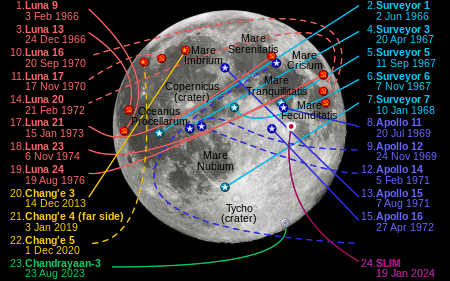If you missed the action the JPL Ustream event has been archived at:
December 17, 2012
----------------------
----------------------
Before touchdown, when the moon was in day light, LRO imaged the expected crash point and will image it again when the moon is lite. The actual crashes occurred while the lunar ridge was in shadow. The little washing machine sized spacecraft were destroyed but the flash wouldn't be bright enough to have been imaged here on Earth.
(Someone can prove me wrong but having passed over a ridge on the northern part of the moon wouldn't help)
- LRK -
Impact points to be named after Sally Ride.
-LRK -
-----------------------
snip
By design, the final resting place was far away from the Apollo landing sites and other historical spots on the moon.
After the double impacts, mission chief scientist Maria Zuber of the Massachusetts Institute of Technology said the spot has been named after team member Sally Ride, the first American woman in space, who died earlier this year.
snip
-----------------------
NASA has named the site where twin agency spacecraft impacted the moon Monday in honor of the late astronaut Sally K. Ride, who was America's first ...
› Read More
-----------------------
This now adds two more spacecraft on the moon and and their respective debris fields.
- LRK -
-----------------------

-----------------------
As an added bit of information about the previous Apollo liter topic I am copying an email I received from Hu Davis.
With permission.
- LRK -
-----------------------
Larry,
Re trash on the Moon, I must confess.
LM-5 did not get the benefit of the $10,000 (?) per pound bounty to Grumman of the "Super Weight Improvement Program (SWIP)" to reduce inert mass. An inducement that was afforded for LM-6 and subsequent. Thus, Lunar Module 5, Eagle, was planned to fly in orbit about but not to land on the Moon, as it was considered to be overweight.
My associate, Roger Hicks, and I did not like the idea of our managing the last one to not land, so we did our own inert mass reduction plan in one week - - about 18 months before its flight date - that included no bounty.
We suggested to George Low that, before closing the hatch for ascent, Neil and Buzz toss overboard the unneeded EVA back packs, hoses, descent flight plans, etc. Then, if George refused adding even a pound of inert mass for the18 months before July 16, 1969, we could move up the first landing from October to late July. Something of a Sicilian offer.
He did and it did. LM-5 landed on July 20, 1969, leaving behind the Descent stage, a turned-over American flag, several lunar experiments and all of the junk they had tossed overboard in order to (barely) make the mission. We had about 20 seconds of propellants remaining at shutdown, even at the reduced thrust needed for hovering flight. Buzz reminded me of this in public a number of times, but 20 seconds is a long time in rocket parlance.
During our first lunar orbit, we got what turned out to be a false report that there was a Russian spacecraft of an unknown type in lunar orbit with us. Scary, but false!! We were glad when Eagle landed and we found out there was not a pair of Russians racing us.
On my next Lunar Module 10, for Apollo 15, we also left behind the first lunar rover. Thus, I must plead guilty to being a leading litter bug of the Apollo program. I would do it again! Two national monuments, not trash dumps!
To my recollection, this story was not a part of any of the TV shows or other popular records of Apollo. Why, I do not know, unless SWIP was considered by the policy wonks at NASA Headquarters to have been an expensive embarrassment.
Hu
-----------------------
-----------------------
You may have your own opinions as to the value of continued missions to our moon and how they should be conducted. Please feel free to drop me a line at my Gmail account.
I am getting too old to 'Fly me to the Moon' but you or yours may want to go. (75 New Years Eve) What you find there may be tempered by what has already arrived.
- LRK -
-----------------------
A moon landing is the arrival of a spacecraft on the surface of the Moon. This includes both manned and unmanned (robotic) missions. The first human-made object to reach the surface of the Moon was the Soviet Union's Luna 2 mission on 13 September 1959.[3]
The United States' Apollo 11 was the first manned mission to land on the Moon on 20 July 1969.[4] There have been six manned U.S. landings (between 1969 and 1972) and numerous unmanned landings, though no soft landings have occurred since 1976.

-----------------------
Thanks for looking with me.
- LRK -
Web Site: http://lkellogg.vttoth.
BlogSpot: http://
WordPress: http://lrkellogg.
Newsletter: https://mailman1.
============================================
==============================










